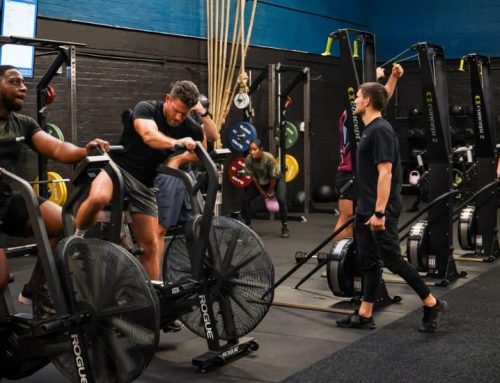Are you tired of having a weak and flabby body? Do you want to gain some muscles and become a shredded human specimen? Well, my friend, weightlifting is the way to go! But before you start flexing in front of the mirror, let’s talk about a potential roadblock that can turn your gym dreams into a medical nightmare: Hernia. Yes, that pesky condition where your intestines decide to punch through your abdominal wall like a scene from a kung-fu movie. But fear not, dear reader, this article is here to guide you through the delicate dance between lifting heavy and keeping your insides, well, inside. So, grab your protein shake and let’s dive into “Weightlifting and Hernia: A Professional Guide.
Contents
- 1 Understanding the Relationship between Weightlifting and Hernia
- 2 Identifying the Different Types of Hernia Commonly Caused by Weightlifting
- 3 Preventing Hernia: Safeguarding Your Health When Weightlifting
- 4 Managing Hernia: How to Deal with the Injury and Get Back to Weightlifting
- 5 Consulting a Healthcare Professional: The Role of Doctors in Weightlifting and Hernia Management
- 6 Picking Up More Than Just Weights
Understanding the Relationship between Weightlifting and Hernia
First and foremost, let’s get one thing clear – weightlifting and hernia aren’t BFFs. That being said, it doesn’t mean you can’t lift weights if you have or have had a hernia. It just means you have to understand the relationship between the two and be cautious. So, let’s dive into what a hernia is and how you can ensure safe lifting.
A hernia is a medical condition where an organ (usually the intestine) pushes through a weak spot in the muscle wall, creating a bulge that can be painful and uncomfortable. Now, imagine you’re trying to lift a barbell over your head with a hernia – not a pretty picture, right?
But fear not, my lifting comrades! With proper technique, form, and caution, you can minimize the risk of aggravating or causing a hernia. Make sure to:
- Warm-up before lifting – don’t just jump straight into heavy weights. Get your blood pumping and muscles loosened up with some light cardio and stretching.
- Focus on proper breathing – don’t hold your breath while lifting, as it can put unnecessary pressure on your abdomen. Instead, take deep breaths and exhale during the lift.
- Start with lighter weights and gradually build up – don’t try to be a superhero and lift heavy weights right off the bat. Slowly increase the weight as your muscles become stronger.
So, there you have it – the relationship between weightlifting and hernia. Remember to be cautious and listen to your body – if something feels off, don’t push it. And if you do feel pain or discomfort, seek medical attention immediately. Happy lifting!

Identifying the Different Types of Hernia Commonly Caused by Weightlifting
When you think of hernias related to weightlifting, your mind jumps straight to the groin area. However, there are many different types of hernias that can cause agony for those who lift.
- The classic inguinal hernia: This is the one you’re probably most familiar with. It produces a lump in your groin area and is a result of a small part of your intestine pushing through a weak spot in your abdominal wall.
- The femoral hernia: This type of hernia also occurs in the groin area, but it is more common in women than men. The lump can be found below the groin crease and is caused by abdominal tissue or intestines pushing through a weakened spot in the upper thigh.
- The umbilical hernia: This hernia forms near your belly button, as a result of abdominal pressure pushing through a gap in your abdominal muscles.
As if lifting heavy weights wasn’t enough of a pain! The risk of hernias during weightlifting increases if you’re not careful with your technique and breathing.
Preventing Hernia: Safeguarding Your Health When Weightlifting
If you’ve ever tried weightlifting, you know how addictive it can be. You feel powerful, strong, and ready to conquer the world. But what about the downsides? Hernias are one of the most common injuries associated with weightlifting, and the truth is, they are no fun.
But fear not, fellow gym-rats! There are some simple ways to prevent hernias and keep your body healthy as you hit those high reps and heavy weights. Here are some tips to safeguard your health:
- Stretch it out: Before you start any weightlifting routine, make sure to stretch properly. This will not only help to prevent hernias, but also reduce the chance of other injuries. Focus on stretching your lower back, abdominal muscles, and hips.
- Use proper technique: Improper form is one of the leading causes of hernias, so make sure you’re lifting with the right technique. If you’re unsure, ask a trainer for help or watch some videos online. Don’t be that guy who throws his back out trying to impress his bros.
- Gradual progress: Don’t go from lifting 5 pounds to 50 pounds in one day. Gradual progress will help your body adjust to the increased strain and prevent hernias. Be patient and remember that slow and steady wins the race.
Don’t let hernias ruin your lifting game. Take these tips to heart and keep yourself healthy as you pump iron and get swole. Your body will thank you.
Managing Hernia: How to Deal with the Injury and Get Back to Weightlifting
Oh no, you’ve got a hernia! Don’t worry, it’s not the end of your weightlifting dreams. Here are some tips to help you manage the injury and get back to lifting those heavy weights like a pro.
- Rest and recover – Give your body time to heal after the injury. Don’t rush back into weightlifting too soon, or you’ll just make things worse.
- Check with your doctor – Make sure you get a proper diagnosis and treatment plan from your doctor. Don’t rely on Google to tell you what to do.
- Modify your workouts – If your doctor gives you the green light to start lifting again, make sure you modify your workouts to avoid aggravating your injury. Swap out heavy squats for leg presses or use a weightlifting belt for added support.
Remember that managing a hernia is all about balance. You don’t want to push yourself too hard and risk further injury, but you also don’t want to be too cautious and miss out on all the gains. Listen to your body and don’t be afraid to ask for help if you need it.
So, there you have it. With a little rest, expert advice, and smart modifications to your workouts, you’ll be back to lifting heavy in no time. Just don’t forget to stretch and warm up before hitting the gym – you don’t want to pull a muscle now, do you?
Consulting a Healthcare Professional: The Role of Doctors in Weightlifting and Hernia Management
Doctors are like superheroes for lifters. They know everything from the muscles that need to be activated for a squat to the perfect diet plan for competition day. So, it is important to trust them when it comes to hernia management. They will carry the burden of responsibility for you, so grab some popcorn, switch off your brain, and let them do the thinking.
When it comes to weightlifting or any physical activity, hernias are like unwanted guests. They invite themselves into your body without an RSVP and refuse to leave. But fear not, because doctors can show these uninvited interlopers the door. From checking for signs of hernia to suggesting preventive measures, a healthcare professional can guide you throughout your journey. They may also advise you on proper lifting techniques and the use of external support, such as belts or wraps.
Doctors always have a backup plan. They might tell you to lay off the heavy lifting for a while, but they will never leave you hanging. They understand that you are passionate about your sport and will work closely with you to help you recover. They will give you a customized plan that is tailored to your specific condition. If surgery is needed, they will explain every step of the process and make sure you are comfortable before proceeding. So, when it comes to weightlifting or hernia management, doctors have got your back.
Picking Up More Than Just Weights
Well, folks, there you have it––a professional guide to weightlifting and hernias. We hope you’ve learned something, and now you’ll be better equipped to avoid any unexpected injuries in the gym. Remember, when it comes to weightlifting, safety always comes first. Plus, we’d hate to see any of you joining the ranks of the one-testicle club. Keep that hernia in check and keep lifting those weights with confidence!








Leave A Comment